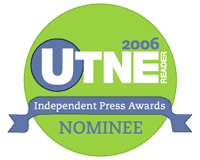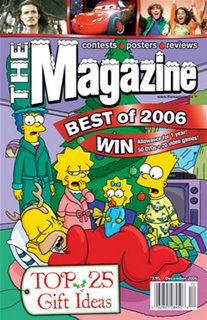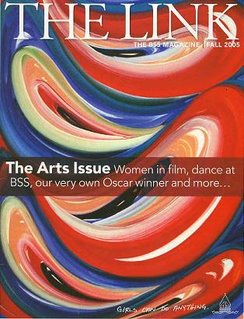The year in Canadian Magazines.
 As we wind down the year (this will be the last post of 2006; best of the season and see you in January), it's time for our list of the good, the bad and the gnarly from the previous year, as posted on Canadian Magazines.
As we wind down the year (this will be the last post of 2006; best of the season and see you in January), it's time for our list of the good, the bad and the gnarly from the previous year, as posted on Canadian Magazines.Physician, heal thyself award to the Canadian Medical Association for first privatizing its prestigious Canadian Medical Association Journal, then firing the editors because they didn't like the idea, then hiring a new editor after much argy-bargy and giving him precisely the kind of editorial freedom and independence that the original editors had asked for.
Here's your hat, what's your hurry? award to The Walrus editor Ken Alexander, who saw most of his most loyal supporters and colleagues bail from the magazine in the past year, but insisted that it was all part of the natural evolution of the magazine. The one thing he didn't acknowledge is that most people who left cited him as being one of the reasons.
Middle-aged, but not wishy-washy award to This Magazine, which turned 40 and doesn't look it or act like it. And to Toronto Life, also turning 40 this year, with a very sprontzy party at the Carlu in Toronto.
Phew, that was close award to Magazines Canada, which lobbied like hell to turn back Canada Post's intention to cut $15 million out of the postal subsidy and were rewarded, pre-Christmas, with an announcement that the subsidy would continue possibly for up to two more years while it figures out what alternatives there are.
It's small, but I like what you're doing with it award to Canadian Dimension, whose redesign is retro, but managed to revitalize this venerable, sometimes cranky, leftish magazine.
The bigger they were, the harder they fell award. Once one of Canada's most successful and highest circulation magazines, TV Guide was put out of its misery (plummeting circ) by Transcontinental, who said that people would get their information onscreen and online, which was apparently what they were doing anyway.
The Lonely in Alberta award to the Western Standard. Publisher Ezra Levant published the so-called Danish cartoons as a matter of principle, the principle being free speech. And almost none of the mainstream media sprang to his defence.
Them's the rules award to the Canadian Society of Magazine Editors and Magazines Canada for stickhandling an update of the ad:edit guidelines that CSME pioneered. It took a blue-ribbon panel (blush, I was one of them) almost 6 months to come up with the guidelines. Smart publishers will put them in their media kits and tell advertisers that they subscribe to them.
So far, no good award to Parachute, one of Canada's oldest arts journals, which gave up the ghost after more than 30 years of publication, when funders apparently gave up on it.
The methodology rag award to Maclean's, which published its lucrative university issue without the help of many of Canada's largest universities. The universities said it was because its methodology was flawed. But the truth is they hated being ranked and it had rankled for years that somebody else was making money telling Canadian students what was good and bad about their (dare we say it) public institutions.
The stop looking under the cushions award to the Canada Council, which was given an extra $50 million in funding and launched an open competition for bright ideas from Canadian magazines to get a piece of it.
The trees thank you award to the 20 some Canadian titles that signed the pledge to use Ancient Forest Friendly paper this year.
The decade award to Heather Robertson, who won her class action suit (which took that long) against the contention that publishers could do whatever they wanted with material they bought from freelancers. The Supreme Court said otherwise.
The sweet deal award to Rogers and Canada Post, who partnered to send a free magazine called Chocolat to people who move in Canada, using the post office's change of address database and Rogers's publishing expertise. Some people were less than happy that the post office was going into competition with its own customers.
The it seemed like a good idea at the time award to Dose, the daily magazine published briefly by CanWest MediaWorks and closed ; it suffered from a) too much circulation and b) too little advertising. It was fun and interesting, but that wasn't enough.
The don't know whether to laugh or cry award to Statistics Canada, which reported that the average Ontario household spends $69 a year on periodicals in 2003; almost exactly what was spent in 1996.
The blockbuster trade award to Glacier Enterprises, a former bottled water company from B. C. that in January purchased all the trade magazine properties in the Business Information Group that had formerly been part of the mighty, now vanished, Southam empire.
We're watching, you know award to the National Post, which little magazine Spacing caught filching a blog entry without asking permission. It wasn't a good year for the Post, which also won the Regret the Error prize for the most grovelling apology on another story.
Go back to looking under the seat cushions award to the Professional Writers of Canada (PWAC), which published a study that says freelancers are actually earning less in constant dollar terms, than they were five years ago.
The club that will have me as a member award to the Canadian Freelancers Union, which announced its organizing drive to get magazine contributors a square deal.
Now THAT'S a line extension award. Saltscapes announces that it is considering going into the restaurant business, with eponymous eateries being opened in cooperation with a hotel chain.
The someone's gotta give award to Michael Fox of Rogers, who became the first to receive the well-deserved Volunteer of the Year award from Magazines Canada.
Tears on the celebrity beat award to Torstar, which cut and ran when its new magazine Weekly Scoop failed to meet expectations.
The cheery greeting award to Christopher Loudon, the editor of Hello! Canada, the apparently very successful startup partnership from Rogers.
The playing nice award to Peter C. Newman and Conrad Black, who in January reached a settlement in Black's libel lawsuit against the indefatigable chronicler of the rich and famous (you'll recall that Black had Newman served with the papers at the Maclean's 100th birthday bash last year).
All the best of the season and for a running start on 2007.













